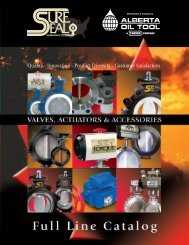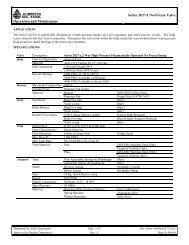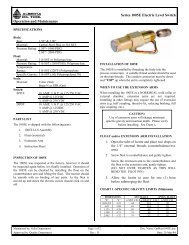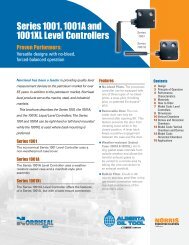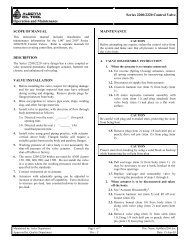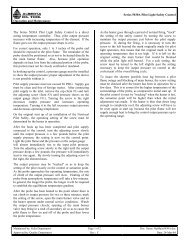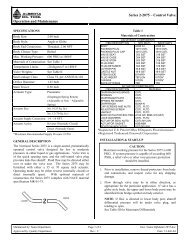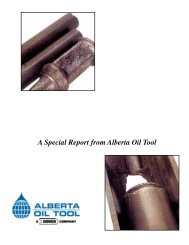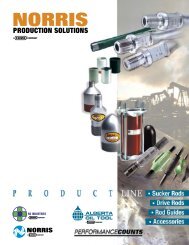NORRISEAL CONTROLS - Alberta Oil Tool
NORRISEAL CONTROLS - Alberta Oil Tool
NORRISEAL CONTROLS - Alberta Oil Tool
- No tags were found...
Create successful ePaper yourself
Turn your PDF publications into a flip-book with our unique Google optimized e-Paper software.
Series 1001A and 1001XL Liquid Level ControllersOperation and MaintenanceINTRODUCTION – SPECIFICATIONSMATERIALS OF CONSTRUCTIONBody: LLC Torque Bar: Aluminum (Std.)1001A ASTM A696/A105 (-20 o F to +600 o F) Flapper Bar: 303 SSTASTM A276/A182 (-70 o F to +600 o F) Spring Adjusting Knot: Aluminum (Std.)1001XL ASTM A216 WCC/A105 (-20 o F to +600 o F) Fulcrum: Nylon w/ Zinc Screw (Std.)ASTM A351 CF8M/A182 (-70 o F +600 o F) Balancing Spring: Light – SST w/ Green MarkingDisplacers: PVC (-20 o F to +140 o F) Medium – SST w/ No MarkingAcrylic (-20 o F to +200 o F)Heavy – SST w/ Yellow MarkingNACE Service 316 SST (-20 o F to +400 o F) Extra Heavy – SST w/ Red MarkingDisplacer Arm: 316 SST (Std.) CONFIGURATIONVertical Hanger (swivel for vertical displacer position):Body End Connections:316 SST (Std.) Sizes (Pipe) 1.5” to 8.0”Chain (for vertical extension and/or split displacer) Beveled – Butt Weld To 6000 PSIG304 SST Threaded (NPT) To 6000 PSIGShaft: 316 SST (-70 o F to +600 o F) Flanged (RF & RT) 150 thru 2500 ANSI ClassCase Mounting –1001A:Bearing Blocks: 316 SST (Std.) (-70 o F to +600 o F) Right Hand Where the body process connection is to the rightBearings: TFE Sealed 440 C SST of the case.(-70 o F to +600 o F) Left Hand Where the body process connection is to the leftof the case.Shaft Seals: Nitrile (-50 o F to +180 o F) Displacer Positions: Horizontal, Vertical, Split, Link,Nitrile Lo-Temp (-70 o F to +180 o F)HV (Horizontal/Vertical),Fluorocarbon (-20 o F to +400 o F)TV (Hinged – Tilt Under)Aflas (-20 o F to +600 o F)Displacer Size (Diameter x Length in inches):EPR (-70 o F to +250 o F)Selection is dependent on sizing for media applicationCase & Cover: Die Cast Anodized Aluminum, with Diameter Range 1.00” thru 4.00”Enamel Paint Length Range 3.00” thru 32.00”Pilot:Diameter x Length combinations are limited within controller construction.Body Displacer Arms Length (inches): 7.75” thru 30.00”Throttle Aluminum w/ Aluminum Seat Balancing SpringRelief Aluminum w/ Elastomer Seat Four Ranges. Color coded dependent on arm length and displacer size.Snap Aluminum Seat Light Duty (Green) Medium Duty (None)Snap-Vibration Service Aluminum w/ Plastic Seat Heavy Duty (Yellow) Extra Heavy Duty (Red)Gasket Diaphragm Nitrile (Std.), Fluorocarbon (Opt.)Filter Element 40 micron Phenolic Resin Impregnate FeltScrews & Nuts SSTSupply & Output Gauges:Brass (Std.), 316 SST (Opt.)Brass Liquid Filled (Opt.)316 SST Liquid Filled (Opt.)Maintained by: Sales Department Page 5 of 21 Doc. Name: OpMain1001.docApproved by: Quality Department Rev.: C Date: 23-Jun-03
Operation and MaintenanceSeries 1001A and 1001XL Liquid Level ControllersINSTALLATION AND STARTUP – CONFIGURATIONThe following drawings illustrate some of the standard configurations of Norriseal's level controllers. Utilize these drawings toverify that your level controller is properly configured.Maintained by: Sales Department Page 6 of 21 Doc. Name: OpMain1001.docApproved by: Quality Department Rev.: C Date: 23-Jun-03
Operation and MaintenanceSeries 1001A and 1001XL Liquid Level ControllersINSTALLATION AND STARTUP – CONFIGURATION (continued)The following drawings illustrate some of the standard configurations of Norriseal’s level controllers. Utilize these drawings toverify that your level controller is properly configured.Series 1001AMounted to vertical chamberSeries 1001AWith horizontal chamberMaintained by: Sales Department Page 7 of 21 Doc. Name: OpMain1001.docApproved by: Quality Department Rev.: C Date: 23-Jun-03
Operation and MaintenanceSeries 1001A and 1001XL Liquid Level ControllersINSTALLATION AND STARTUP – CONFIGURATION (continued)The following drawings illustrate some of the standard configurations of Norriseal’s level controllers. Utilize these drawings toverify that your level controller is properly configured.LEFT HAND MOUNTDIRECT ACTINGRising level IncreasesPilot OutputRIGHT HAND MOUNTDIRECT ACTINGRising Level IncreasesPilot OutputLEFT HAND MOUNTREVERSE ACTINGRising Level DecreasesPilot OutputRIGHT HAND MOUNTREVERSE ACTINGRising Level DecreasesPilot OutputMaintained by: Sales Department Page 8 of 21 Doc. Name: OpMain1001.docApproved by: Quality Department Rev.: C Date: 23-Jun-03
Operation and MaintenanceSeries 1001A and 1001XL Liquid Level ControllersINSTALLATION AND STARTUP – STARTUPNorriseal level controllers are normally shipped in threepieces. Therefore, some assembly is required. Thefollowing sections will lead you through assembly andrecommended start-up procedure.Assembly Steps:1. Screw displacer arm into controller body.2. Screw displacer onto displacer arm.Arm Adjustment:Rock Torque Bar by hand to verify Arm is NOT restingagainst vessel nozzle. (Arm must be reasonably centeredin connection opening). Turn Adjusting Knob underBalance Spring to position Arm.To Lower Level:Turn Adjusting Knob CLOCKWISE to increasecompression on Balance Spring.To Raise Level:Turn Adjusting Knob COUNTERCLOCKWISE todecrease compression on Balance Spring.To Adjust Proportional Band (Span):Loosen Screw in Sensitivity Fulcrum and slide Fulcrumalong Flapper Bar. To DECREASE Proportional Band(INCREASES SENSITIVITY) slide Fulcrum towardSnap Ring. To INCREASE Proportional Band(DECREASES SENSITIVITY) slide Fulcrum awayfrom Snap Ring.Maintained by: Sales Department Page 9 of 21 Doc. Name: OpMain1001.docApproved by: Quality Department Rev.: C Date: 23-Jun-03
Series 1001A and 1001XL Liquid Level ControllersOperation and MaintenanceOPERATION – PRINCIPLE OF OPERATIONPrinciple of OperationA spring balances theweight of a displacementtype sensing element. Asliquid rises around thedisplacer, the amount offorce made available tothe pilot is proportional tothe volume of liquiddisplaced by the displacer.The higher the liquidlevel, the greater the forceavailable to the pilot thrustpin. This direct-acting force is easily reversed in the field.The force available is transmitted to the pilot thrust pinthrough a lever and fulcrum. The control is direct acting(rising level increases pilot output) when the pivot point ofthe lever is on the spring side of the control case.The control is reverse acting when the pivot point is on theopposite side of the control case from the spring (rising leveldecreases pilot output).Adjusting Proportional Band:Moving the fulcrum closer to the pivot point increases theproportional band*; moving the fulcrum toward the snapring decreases the proportional band. A 3-15 psi or 6-30 psioutput signal may be obtained over any portion of thedisplacer by adjusting the fulcrum as described.Top Level Control:With spring force heldconstant, the higher theliquid level on the displacer,the greater becomes theforce available to the pilot.When spring force isreduced (by decompressingthe spring), a higher levelon the displacer is requiredto produce the same force asbefore.Liquid Interface Control:Spring compression can bereduced to a further positionwhere a hydrocarbon liquidlevel will rise above thedisplacer.This wide spring rangemakes the control of aliquid interface possiblewith the standard displacer.The adjustment is usuallymade as the lighter liquidrises on the displacer.After the spring is adjustedso the lighter liquid will notoperate the control, there isadequate spring force inreserve to enabledisplacement of the heavierliquid to actuate the pilot.• Proportional band is the ratio of used displacerlength to total length of displacer. Example: If sixinches of level change will develop a 3-15 psioutput signal with a 12" long vertical displacer, thelevel controller is said to have a 50% proportionalband.Maintained by: Sales Department Page 10 of 21 Doc. Name: OpMain1001.docApproved by: Quality Department Rev.: C Date: 23-Jun-03
Operation and MaintenanceSeries 1001A and 1001XL Liquid Level ControllersOPERATION – PRINCIPLE OF OPERATION, SNAP PILOT, RELIEF PILOT AND THROTTLE PILOTSnap PilotThe snap pilot is comprisedof two metal seated valves -one at "D" to admit pilotsupply pressure, and one at"C" to exhaust pressure.Ball "A" controls the flow ofinstrument air into the pilotat seat "D" and is heldclosed with force exerted bysupply pressure on theseating area of the ball.When the upwardmechanical force transmittedto thrust pin "B" is sufficientto overcome the forceholding ball "A" seated, "A"snaps upward allowinginstrument air to flow past "A" and to the output port "H" ofthe pilot.The spherical end of thrust pin "B" closes the exhaust port at"C" the instant ball "A" snaps upward. The exhaust portseating area is smaller than the seating area of the supplyport; therefore, the push rod must remain seated againstsupply pressure until force on the thrust pin "B" diminishes.As the force acting on thrust pin "B" is reduced the supplypressure acting downward on ball "A" overcomes theupward force at thrust pin "B" and reversing action occurs.ball "A" closes the supply pressure at valve "D" andsimultaneously opens the exhaust port at valve "C"; thusventing gas from port "H". The Snap Action results from thedifferences in seating areas of the two internal pilot valves.Relief PilotThe relief pilot used in Block &Bleed systems operatesidentically to the snap pilot,except with two differences.Seat "D" has an added resilientseat "F" and flow passage at "G"is enlarged. The seat seal "F" isan elastromeric o-ring whichgives air absolute "zero leakage"seal of the supply pressure at ball"A". Just as in the snap pilot,when mechanical forcetransmitted through thrust pin"B" exceeds the downward forceof the supply pressure at seat"D", ball "A" snaps upwardallowing instrument air to flow past ball "A" and to port "H".The flow passage at "G" has a 43% larger flow capacity thanthe snap pilot; thus permitting instrument supply air to ventat a faster rate. The pilot valves will reset when mechanicalforce is reduced.The relief pilot cannot be converted into snap or throttleapplication.Throttling PilotThe throttle pilot, used formodulating control, also utilizestwo internal valves ("D" and "C")to admit and exhaust air pressure.A diaphragm "E" used inconjunction with the valve at "C"creates a chamber for sensingpressure/force feedback.When a mechanical force pushesupward on thrust rod at "B", thevalve at "C" is closed andsimultaneously opens valve "D"allowing instrument air to flowinto the chamber above diaphragm"E" and to output "H". The aircontinues flowing until theincreasing pressure builds afeedback force on diaphragm "E"that pushes downward equalizing the upward force appliedto thrust rod "B". These balanced forces are the reason tothe term "Force Balance."The throttle pilot works in the same manner as the snap pilotexcept the output pressure is proportional the mechanicalforce applied at push rod "B". As the push rod forcechanges, the pilot seeks to maintain equilibrium by eitherdecreasing (exhausting) output loading pressure at valve "C"or increasing output loading pressure at valve "D".Instrument air does not flow when the loading pressures ofthe pilot are balanced.Maintained by: Sales Department Page 11 of 21 Doc. Name: OpMain1001.docApproved by: Quality Department Rev.: C Date: 23-Jun-03
Operation and MaintenanceSeries 1001A and 1001XL Liquid Level ControllersOPERATION – ELECTRIC PILOT SWITCHESEXPLOSION-PROOF AND SPLASH PROOF ENCLOSURESElectric Pilot SwitchesTwo standard switches are available, single pole doublethrow (SPDT) or double pole double throw (DPDT).CODE CIRCUITRY ELECTRICAL RATING“E” EX-Qor“O” OP-QSingle – PoleDouble – ThrowGreen - GroundAUL and CSA Listed:15 amps, 125, 250 or 480 VAC1/8 hp, 125 VAC; 1/4 hp, 250 VAC;1/2 amp, 125 VDC; 1/4 amp, 250 VDCnot sealed and therefore are not recommended for use inareas where they will be subjected to liquid splash.Micro Switch "EX" switches are listed by Underwriter'sLaboratories and CSA for use in hazardous locations Class1, Groups C and D, and Class 2, Groups E, F and G. Thisincludes vapors of ethyl ether, gasoline, petroleum, alcohol,acetone, lacquer solvent, natural gas and atmosphere chargedwith grain dust, metal dust, carbon black, and coal or cokedust. Switch listed for Class 1, Group B (hydrogenatmosphere) is available. EX switches also meet NEMA 1enclosure requirements. CSA requires the followingstatement for Class 1, Group B:“D” EXD-Qor“F” OPD-Q“K”Hermetic030Black – Com1Black – Com2Double – PoleDouble – ThrowGreen - GroundBlue – N.O.1Red – N.C.1Blue – N.O.2Red – N.C.2HERMETICALLY SEALED PILOTSingle – PoleDouble - ThrowRed – N.C.Blue – N.O.Green - GroundBUL and CSA Listed:10 amps, 125 or 250 VAC.3 amp, 125 VDC; .125 amp, 250 VDC11 amps, 1/4 hp @ 125/250 VAC;5 amps Res @ 28 VDC;CAUTION:To prevent the emission of hot particles, joint surfaces mustbe thoroughly cleaned before closing cover.ATTENTION:Pout empecher la projection de particles chaudes, les jointsdu couvercle doivent etre nettoyes a fond avant de fermer lecouvercle.Hermetically Sealed Enclosure for Hazardous LocationsThese switch leads are terminated in a junction box ULlisted Class 1, Groups C and D, Class 2, Groups E, F and G.The switches are hermetically sealed for hazardous locationslisted UL and CSA Class 1, Groups A, B, C and D; Class 2,Groups E, F and G.Blue – N.O.10.5 amps @ 125 VDC“L”Hermetic057Brown – Com1Yellow – Com2Red – N.C.1Purple – N.O.2Black – N.C.2Double – PoleDouble - Throw“EX” Explosion-Proof EnclosureFlame paths within the housings of these switches coolexploding gases below the kindling temperature before theyreach explosive gases surrounding the housing.The enclosed replaceable basic switch is accessible when thecover plate is removed. “EX” explosion-proof switches areMaintained by: Sales Department Page 12 of 21 Doc. Name: OpMain1001.docApproved by: Quality Department Rev.: C Date: 23-Jun-03
Series 1001A and 1001XL Liquid Level ControllersOperation and MaintenanceOPERATION – CONTROL ADJUSTMENTS, CASE MOUNTING AND ACTION CONVERSIONSCONTROL ADJUSTMENTS– LEVEL, SENSITIVITY & LIQUID INTERFACELevelNote: All controls are preset at factory for average level andsensitivity. Normally no further adjustment is required. Thesquare head screw under the torque bar is used only for fineadjustment on metering applications to set an exactincrement of dump.Case Mounting and Action ConversionThe following are instructions for the disassembly,conversion and re-assembly of all parts involved in casemounting and/or controller action of liquid level controls.1. Compress balance spring with adjusting knob tobalance weight of displacer.2. Make sure displacer arm is not resting againstvessel nozzle by rocking torque bar.• To Lower Level - Increase spring compression.• To Raise Level - Decrease spring compression.Sensitivity1. Loosen locking screw on the sensitivity fulcrum.2. To Increase Sensitivity - Slide fu lcrum nearerSnap Ring.3. To Decrease Sensitivity - Slide fulcrum away fromSnap Ring.4. Tighten locking screw. Finger tight only required.Liquid Interface1. Set sensitivity fulcrum 1/4" from snap ring, reducespring tension slowly and let the upper fluid ris e tosubmerge the displacer. For fine tuning afterdisplacer is submerged in upper fluid, increasespring tension slowly until an output signal isobtained; back-off spring tension again (slowly)until output signal pressure returns to zero. Theinstrument is now ready to control the lower fluid.2. Let lower fluid rise on displacer until desired levelis reached. This can be accomplished by reducingspring tension slowly as fluid rises.3. If a longer dump span is desired, move fulcrumfarther away from snap ring and repeat the aboveprocedure.Pilot Action (Direct to Reverse, or Reverse to Direct)Disassembly(Note location and position of parts before proceeding)1. Relax all tension on balance spring (item 16).2. Remove 10/32 lock nut (item 46 or 47) from pivotpin.3. Slide flapper bar (item 2) from pivot pin.4. Remove thumb screw (item 45 or 46) fromsensitivity fulcrum (item 15).5. Replace thumb screw (item 45 or 46) in oppositehole of fulcrum from which it was originallyremoved.6. Reverse position of flapper bar (item 2).7. Slide flapper bar on opposite pivot pin from whichit was originally removed. Thumb screw (item 45or 46) should be facing outward and fulcrum (item15) should be facing so that the longest side (withcontact point) is closest to the retaining ring (item14) on the flapper bar (item 2).8. Install 10/32 lock nut (item 46 or 47) to retainflapper bar (item 2). (Flapper bar must remain freeto pivot).9. Adjust tension on balance spring (item 16).Maintained by: Sales Department Page 13 of 21 Doc. Name: OpMain1001.docApproved by: Quality Department Rev.: C Date: 23-Jun-03
Series 1001A and 1001XL Liquid Level ControllersOperation and MaintenanceOPERATION – CONTROL ADJUSTMENTS, CASE MOUNTING AND ACTION CONVERSIONS (continued)Procedure for Case Mounting ConversionDisassembly(Note location and position of parts before proceeding)1. Relax all tension on balance spring (item 16).2. Remove balance spring (item 16) and upper springretainer (item 24) from pilot case (item 1).3. Remove 3/8-24 x 1.75" cap screw (item 51 or 52)and lower spring retainer (item 33) from case (item1).4. Remove 2, 10/32 lock nuts (item 46 or 47). (Use7/16 wrench.)a. One nut on end of shaft (item 32).b. One nut on pivot pin retaining flapper bar (item2).5. Slide flapper bar (item 2) from pivot pin.6. Slide torque bar (item 36) from shaft (item 32).7. Loosen 2, 1/4" hex head cap screws (items 42 or44) in level adjusting bar (item 17). (Use 1/2 boxendwrench).a. Holding level adjusting bar (item 17), loosenboth screws until level adjusting bar (item 17)is free on shaft (item 32).b. Slide level adjusting bar (item 17) from shaft(item 32).c. Slide spacer (item 26) from shaft (item 32).8. Remove 2, 1/4-28 x 3/8" hex head cap screws (item41 or 45) so that pilot case (item 1) is loose. (Use1/2 socket wrench.)9. Remove case (item 1) from level control body (item54 or 55).Conversion and Re-Assembly(See drawings for desired mounting location.)1. Install 2, 1/4-28 x 3/8" hex head cap screws (item41 or 45) into case mounting holes.a. Mount case (item 1) to body (item 54 or 55)with 2 screws.b. Tighten screws. (Torque to 6 ft. lbs.)2. Slide spacer (item 26) on the shaft (item 32).3. Level Adjusting Bar (item 17).a. Position level adjusting screw (item 35) so thatthere is equal amount of thread showing aboveand below bar.b. Slide level adjusting bar (item 17) on shaft(item 32) against spacer (item 26).c. Snug up 2, 1/4-28 x 3/8" hex head cap screws(item 41 or 45) in bar. (Do not tighten.)d. Slide torque bar (item 36) on shaft (item 32)temporarily for positioning of level adjustingbar (item 17).e. Position level adjusting bar (item 17) so thattorque bar is parallel with displacer arm (item23) when the round tip of level adjusting screw(item 52) is touching the torque bar (item 36).f. With level adjusting bar (item 17) positioned -slide torque bar (item 36) from shaft andtighten 2, 1/4-28 x 3/8" hex head cap screws(items 41 or 45). Tighten screw nearest theslotted end of the level adjusting bar first.(Torque to 6 ft.lbs.)4. Slide torque bar (item 36) onto shaft (item 32) withcountersunk hole for spring retainer (item 24)facing down.a. Left Hand Mount - Hole is on the left side.b. Right Hand Mount - Hole is on the right side.Maintained by: Sales Department Page 14 of 21 Doc. Name: OpMain1001.docApproved by: Quality Department Rev.: C Date: 23-Jun-03
Operation and MaintenanceSeries 1001A and 1001XL Liquid Level ControllersOPERATION – CONTROL ADJUSTMENTS, CASE MOUNTING AND ACTION CONVERSIONS (continued)5. Install 10/32 lock nut (item 46 or 47) on end ofshaft (item 32). (Allow 1/16 inch clearancebetween back of lock nut (item 46 or 47) and torquebar (item 36).)6. Slide flapper bar (item 2) onto pivot pin.a. Left Hand Mount - Direct acting - use left pivotpin.b. Left Hand Mount - Reverse acting - use rightpivot pin.c. Right Hand Mount - Direct acting - use rightpivot pin.d. Right Hand Mount - Reverse acting - use leftpivot pin.7. Install 10/32 lock nut (item 46 or 47) to retainflapper bar (item 2). (Flapper bar mu st remain freeto pivot.8. Install 3/8-24 x 1.75” cap screw (item 51 or 52) andlower spring retainer into lower pilot case (item 1).a. Left Hand Mount – Bolt (cap screw) stud is atleft side.b. Right Hand Mount - Bolt (cap screw) stud is atright side.9. Install spring (item 16) and upper spring retainer(item 24) engaging retainer with hole in torque bar(item 36).DIMENSIONS*Using standard 1.875” dia. x 12” displacer and 12.5” displacer arm.Length is dependant upon displacer arm and displacer.MODEL1001A 1001XLA 8.74 8.74B 3.85 3C 4.13 4.13D 6 6E 13.12* 13.12*F 24.43* 24.44*G 4.36 4.36H 3.95 3.95I 1.9 1.9J 2.98 2.98K 7.98 7.98L 5.19 ---M 7.47 ---N 0.69 0.69O 7.13 ---P 7.85 7.85Q 4 4R 7.06 7.06S 8.01 8.01T 1/4 NPT 1/4 NPTU 4.87 5.16Maintained by: Sales Department Page 15 of 21 Doc. Name: OpMain1001.docApproved by: Quality Department Rev.: C Date: 23-Jun-03
Operation and MaintenanceSeries 1001A and 1001XL Liquid Level ControllersOPERATION – CONTROL ADJUSTMENTS, CASE MOUNTING AND ACTION CONVERSIONS (continued)OPERATION – MAINTENANCEPreventive Maintenance1. In normal service o-ring and bearings on main shaftshould last for many years. If leak does occur,replace o-rings.2. If controller is used in high paraffin service orinterface control with horizontal displacer, removeand inspect body of controller after three (3)months from installation and check for debris buildup. Inspection time after initial inspection can begaged by how much build up of debris occurred inthree (3) months.3. For high temperature service, consult yourNorriseal Catalog. If in doubt of compatibility offluid with Norriseal Controller, consult yourNorriseal Representative.Basic Electric SwitchThe following are instructions for replacing the electricswitch:1. IMPORTANT - Disconnect the power supplycircuit before opening switch.2. Remove the cover of the housing, disconnect thelead-in wires, loosen the screws holding the basicswitch, and then remove the basic switch.3. Place the replacement switch in the insulator, insertthe screws and place basic switch in the housing.Switches with "MN" basics have no separateinsulator.4. Tighten the screws and connect the lead-in wires.5. Be sure the small compression spring is returned toits position between the top of the basic switch andthe internal lever (or above the internal lever in thecase of the CCW actuated switches).CAUTIONTo prevent the emission of hot particles, joint surfaces mustbe thoroughly cleaned before closing cover.ATTENTIONPout empecher la projection de particles chaudes, les jointsdu couvercle doivent etre nettoyes a fond avant de fermer lecouvercle.Maintained by: Sales Department Page 16 of 21 Doc. Name: OpMain1001.docApproved by: Quality Department Rev.: C Date: 23-Jun-03
Operation and MaintenanceSeries 1001A and 1001XL Liquid Level ControllersWARNING SIGNAL IMMEDIATE CAUSE CORRECTIVE ACTIONSpring is too compressed and puts too 1. Back off spring retainer until outputmuch pressure on torque bar.pressure signal goes off. RecheckDisplacer is set too high or displacer is when fluid rises.hitting something inside vessel.Pilot output pressure gage indicated outputpressure signal when fluid level is belowdisplacer on a direct acting* controller.2. Check displacer arm by movingleveling bar up and down. If levelingbar will move in only one direction,this indicates displacer arm is riding ateither the top or bottom of vesselconnection. By turning thumb screwdisplacer arm can be re-centered invessel connection.Fluid level above displacer and pressuregage indicates no output signal for a directacting* control.Controller does not repeat at same fluidlevel after each dump and sometimes fails toeither dump or shut off.Spring is not compressed enough.Displacer arm is set too low.Paraffin or debris build up inside level controlbody.1. Turn spring retainer which willcompress spring. Turn until an outputsignal is indicated by showing pressureon the output pressure gage. Outputpressure should go off when fluid leveldrops down to the displacer'scontrollable range.2. Same as in (2) above.Remove controller from service and cleanout pilot body with a solvent. You canusually tell there is a build up of paraffin ordebris by depressing the torque bar and thereleasing it quickly. If bar does not bouncefast and appears to hardly move, this is agood indication of a build up of foreignmatter in controller body in which displacerarm cannot move freely.Pneumatic pilot bleeds air continuously. 1. Foreign matter under ball on snapcontrol pilot or under peanut on throttlepilot.2. TRU arc ring on snap pilot thrust pincould have slipped down due to someunusual happening.Remove supply and output tubingconnections from pipe adapters in pilot.Remove the two (2) cap screws from the topof housing case that support pilot in place.Remove pilot from case and then remove thetwo (2) cap screws from bottom of pilot.Clean pilot thoroughly and reassembly forthrottle pilot. For snap pilot, check the TruArc dimension from the bottom of in tobottom of Tru Arc. Dimension should be3/4". If not correct dimension, tap to correctmeasurement.Interface control; occasionally loses liquidor vessel overflows. Usually happens withtemperature change. Displacer arm is freeand displacer is not hitting inside of vessel.Displacer is not big enough to handleinterface differential. Close specific gravityof two fluids and a temperature change cancause this problem.Exact specific gravities or API gravity ofboth fluids should be given to NorrisealEngineering Department for exact sizing ofrequired displacer size on close gravityfluids*For indirect Acting Controllers follow the same corrective procedures for direct acting controller. WARNING SIGNAL: Except pressure gage outputsignal will be reversed.Maintained by: Sales Department Page 17 of 21 Doc. Name: OpMain1001.docApproved by: Quality Department Rev.: C Date: 23-Jun-03
Operation and MaintenanceSeries 1001A and 1001XL Liquid Level ControllersSERIES 1001A LIQUID LEVEL CONTROLMaintained by: Sales Department Page 18 of 21 Doc. Name: OpMain1001.docApproved by: Quality Department Rev.: C Date: 23-Jun-03
Operation and MaintenanceSeries 1001A and 1001XL Liquid Level ControllersSERIES 1001A LIQUID LEVEL CONTROLMaintained by: Sales Department Page 19 of 21 Doc. Name: OpMain1001.docApproved by: Quality Department Rev.: C Date: 23-Jun-03
Operation and MaintenanceSeries 1001A and 1001XL Liquid Level ControllersSERIES 1001XL LIQUID LEVEL CONTROLMaintained by: Sales Department Page 20 of 21 Doc. Name: OpMain1001.docApproved by: Quality Department Rev.: C Date: 23-Jun-03
Operation and MaintenanceSeries 1001A and 1001XL Liquid Level ControllersSERIES 1001XL LIQUID LEVEL CONTROLMaintained by: Sales Department Page 21 of 21 Doc. Name: OpMain1001.docApproved by: Quality Department Rev.: C Date: 23-Jun-03




